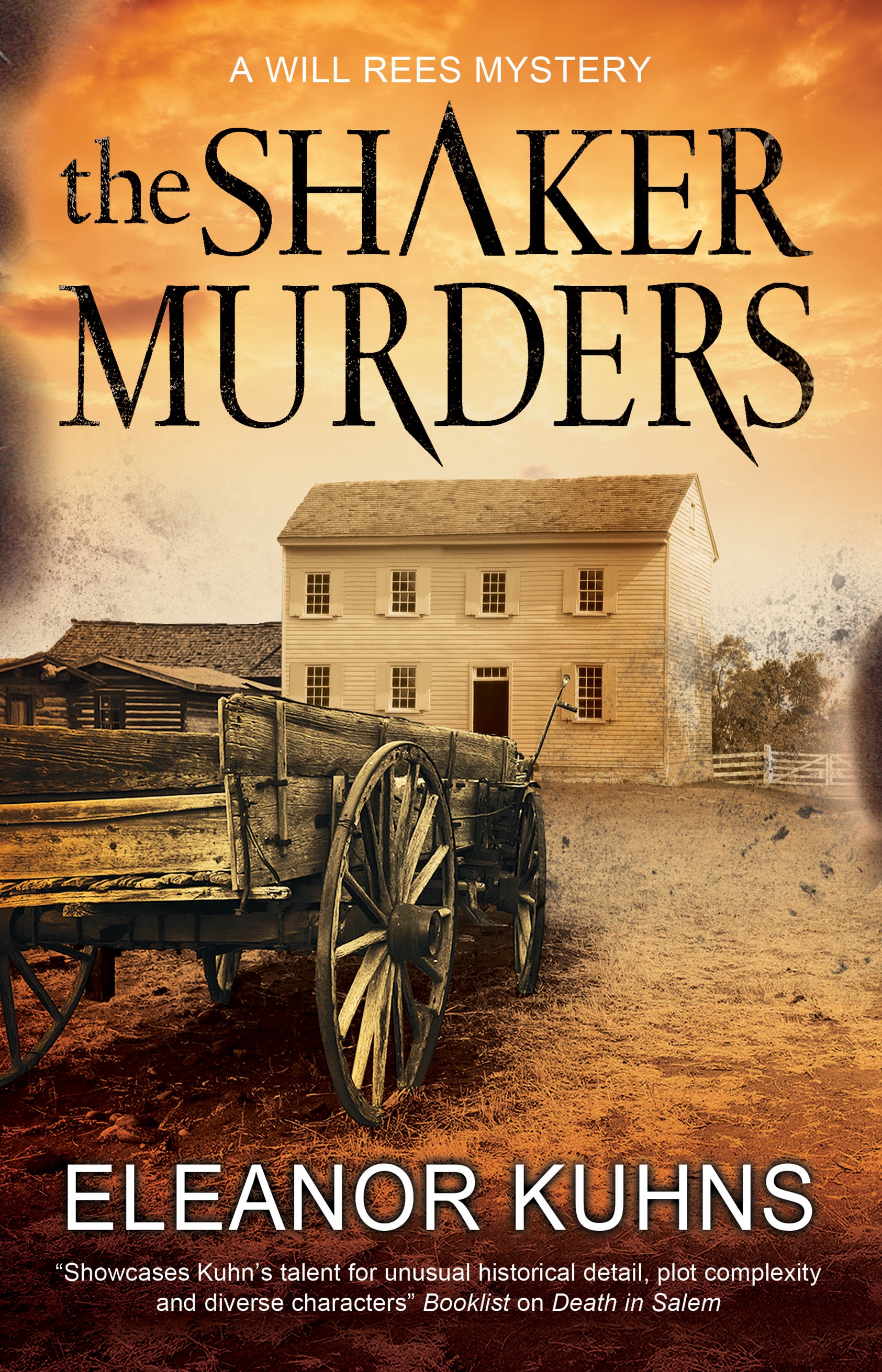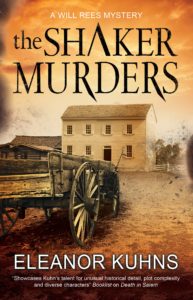Today was a banner day for me. I received two wonderful reviews of The Shaker Murders, one included in Library Journal.
Author Eleanor Kuhns Weaves A Mystery
 Traveling weaver, Will Rees arrives in Zion, Maine, a Shaker community, amidst a series of bizarre accidents. As Rees investigates, he begins to experience nightmares where his family is in jeopardy. In this sixth book in the Will Rees series, author Eleanor Kuhns has readers racing along to learn if Rees can uncover the truth before those haunting dreams become a reality.
Traveling weaver, Will Rees arrives in Zion, Maine, a Shaker community, amidst a series of bizarre accidents. As Rees investigates, he begins to experience nightmares where his family is in jeopardy. In this sixth book in the Will Rees series, author Eleanor Kuhns has readers racing along to learn if Rees can uncover the truth before those haunting dreams become a reality.
Lifelong librarian and award-winning author Eleanor Kuhns’s latest novel in her Will Rees series, The  Shaker Murders (Severn House), was inspired in part by a fortuitous trip to Sabbathday Lake Shaker Village, a tiny religious community that was established in Maine in 1783.
Shaker Murders (Severn House), was inspired in part by a fortuitous trip to Sabbathday Lake Shaker Village, a tiny religious community that was established in Maine in 1783.
If Kuhns hadn’t created this popular series when she did, there’s a fair chance there would be no Shakers left to share their traditions firsthand. Due to the sect’s adherence to celibacy, the practice of marrying out, and expulsion from the community for violating rules like refusing to shave one’s beard, today Sabbathday Lake is home to only three remaining Shakers.
“All I knew about the Shakers was that they made furniture,” Kuhns tells Library Journal. “In the tour, I learned they were celibate, and they took in orphans.”
Kuhns was so intrigued by what she saw, she bought every book in the gift shop and embarked on a period of research that yielded more than a few surprises.
“Who knew that their herbal business was so successful that in today’s money, it would be a billion dollar industry or that they were accomplished inventors with hundreds of patent applications?” Kuhns says enthusiastically.
The more research Kuhns conducted, the more she wondered about the people who joined the Shaker community. Kuhns learned that some converts were driven by faith, others saw it as an escape from societal conventions like marriage, and then there were those who used the sect to hide out – fertile motivation for an author of mysteries.
Returning readers of Kuhns’s mystery fiction have come to expect to learn a few things along with seeing a murder get solved. “Every book features at least one job that was important to the times. In Death of a Dyer I describe dyeing, in Cradle to Grave it is barrel making, and in Death in Salem I focus on sail and rope making,” Kuhns says.
In The Shaker Murders, Kuhns introduces the reader to the art and cultural history of weaving. “One of my hobbies is weaving, so I made my main character a weaver,” Kuhns says, adding, “I knew how to thread and set up the treadles and follow a pattern, but after I started working with Rees, I studied the history of weaving, an unbroken line from the Bronze Age to the Industrial Revolution.”
In The Shaker Murders, the craft of weaving offered her protagonist, Will Rees, some connective material to move the story along. “Weaving gives Rees the chance to interact with women as well as men. That would have been much more difficult if I’d made him a bricklayer,” Kuhns adds.
Kuhns explains that in the Shaker community, women wove in the home, but some male weavers were itinerant, which enables Kuhn’s murder-solving protagonist to have a reason to leave the small town in Maine. To further aid in this, Kuhns made him a traveler, so he has more than one motivation to hit the road.
In her earlier works like Cradle to Grave, Rees solves a murder just north of Albany that involves the Shaker community there. In Death in Salem, Rees visits Salem, Mass that was, at that time, the sixth largest city in the U.S. as well as the wealthiest due to trade with India and China.
For Kuhns, one character remains with her above the others. Kuhns created Calvin, a mentally challenged man whose untimely end hit her the hardest. “I don’t think the developmental disabilities are new in modern times, so his murder is even more heinous and emotional wrenching because he is an innocent.”
When Kuhns originally sought inspiration for Rees, she found it in her late father, himself an adept craftsman. “Part of Will Rees is completely my father: his sense of justice, his honesty and his ability to work with his hands. He was also a big red-headed fellow with anger issues,” Kuhns says.
For Kuhns, the process of drawing upon her father has been educational. “Since writing about Rees and doing such intensive research into earlier times, I feel I understand my father a lot better. I hope he would be flattered.”
Traditionally, when Kuhns casts that role in her mind, she’s thought of Damien Lewis (from Homeland) and David Wenham (Faramir in the Lord of the Rings), but she jokes she may need to find someone younger as they’re getting on. With such leading men as inspiration for a character based on her father, how could he not be?
The second review came from the Historical Novel Society.
The Shaker Murders (A Will Rees Mystery)
Will Rees and his family are hiding in Zion, a Shaker community in Maine, and hoping to find safety, but what Will discovers is a secretive sect and two murders that threaten the security of his family in Kuhns’ sixth Will Rees Murder series. Will, his pregnant wife, Lydia, and their children fled their hometown of Dugard and are in Zion because of an accusation of witchcraft against Lydia, and Will’s own murder charges—from which he cleared his own name (The Devil’s Cold Dish, 2016). Shortly after arriving in Zion, Brother Jabez is found dead in the laundry. Will is certain it was murder, but Elders Solomon and Jonathan push it off as an accident. After Will finds the murder weapon, and a second Shaker—a simple-minded young man—is killed Will is certain that the murderer is one of the Shakers themselves. Complicating matters is the matter of Lydia’s former farm, which the Shaker community believes belongs to them but Will hopes to take for his family.
While this is a murder mystery, what really sets this book apart are the descriptions of daily life and expectations for 18th-century Shakers and their community—including guests that they welcome with open arms, if only because they hope these people will sign the Covenant and join. As in any whodunit, there are plenty of shady characters, from hired farm boys to newcomers to the community up through the elders themselves, all lending to throw Will, and the reader, off course. Though there are many references to previous books, first-time readers to this series will have no trouble jumping in. Ultimately, Kuhns uses the Shaker beliefs to craft an interesting and suspenseful ending to this delightful story.


